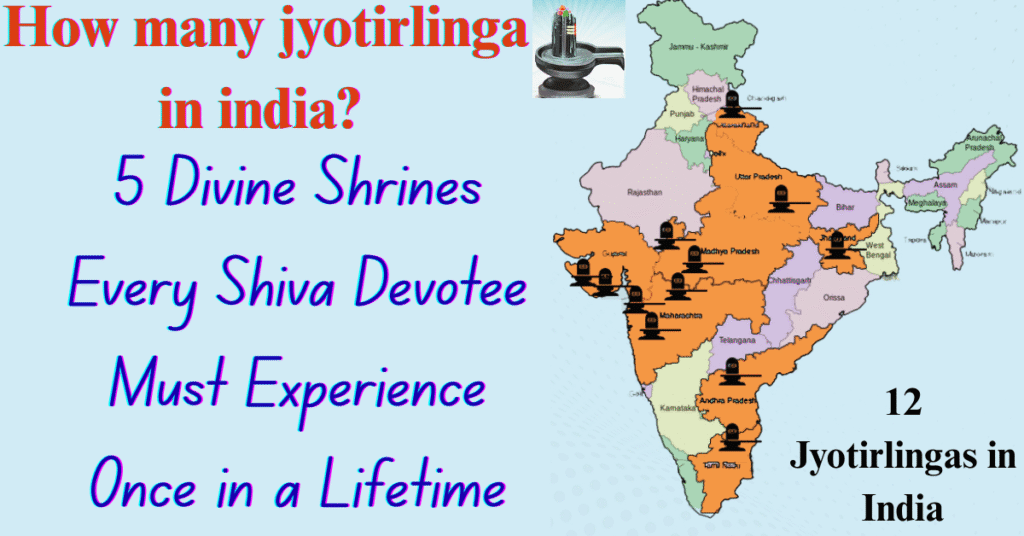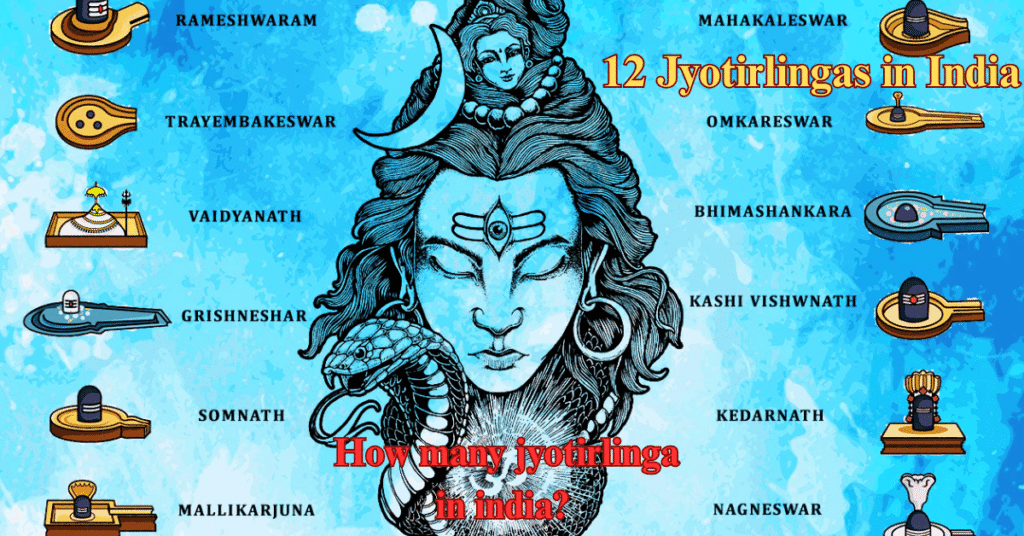
Table of Contents
How many jyotirlinga in india?
How many jyotirlinga in india? : India is a land steeped in spirituality and mythology. At the heart of its sacred geography lie the Jyotirlingas—divine shrines where Lord Shiva is worshipped in his most radiant form as a pillar of light (Jyoti meaning light, Linga meaning sign). These sites are considered the most revered pilgrimage destinations for devotees of Shiva.
🔱 How Many Jyotirlingas Are There in Total?
There are 12 Jyotirlingas in India, spread across various states from the Himalayas to the southern shores. Each Jyotirlinga represents a different manifestation of Lord Shiva, and visiting all 12 is believed to liberate a soul from the cycle of life and death (moksha).
These temples were mentioned in the ancient Shiva Purana, and each is associated with a powerful legend or divine story that enhances its spiritual aura.
📍 Full List of the 12 Jyotirlingas in India

| Jyotirlinga | Location | State |
|---|---|---|
| Somnath | Prabhas Patan | Gujarat |
| Mallikarjuna | Srisailam | Andhra Pradesh |
| Mahakaleshwar | Ujjain | Madhya Pradesh |
| Omkareshwar | Mandhata Island | Madhya Pradesh |
| Kedarnath | Rudraprayag | Uttarakhand |
| Bhimashankar | Pune | Maharashtra |
| Kashi Vishwanath | Varanasi | Uttar Pradesh |
| Trimbakeshwar | Nashik | Maharashtra |
| Vaidyanath (Baidyanath) | Deoghar | Jharkhand |
| Nageshwar | Dwarka | Gujarat |
| Ramanathaswamy | Rameswaram | Tamil Nadu |
| Grishneshwar | Aurangabad | Maharashtra |
🌟 Importance of Visiting Jyotirlingas
- Each Jyotirlinga is believed to be self-manifested (Swayambhu) and radiates spiritual energy.
- Visiting Jyotirlingas is believed to cleanse sins, grant divine blessings, and help attain moksha.
- These temples are centers of Shaivism, and have been worshipped for thousands of years.
- The journey to these sacred shrines is often filled with natural beauty, architectural grandeur, and inner transformation.
🙏 5 Jyotirlingas Every Shiva Devotee Must Visit Once in Life
While all 12 Jyotirlingas are sacred, the following 5 hold special spiritual, historical, and geographical significance. Every devotee should try to visit these at least once in life.
1. 🛕 Kashi Vishwanath Jyotirlinga – Varanasi, Uttar Pradesh
Significance: Known as the “King of Jyotirlingas,” this temple is located in the holy city of Kashi (Varanasi), considered the oldest inhabited city in the world.
- It is believed that Kashi will remain intact even during the cosmic dissolution (Pralay), and Lord Shiva grants moksha to those who die here.
- The current temple was rebuilt by Ahilyabai Holkar in the 18th century.
- It is part of the Sapta Puri pilgrimage.
Must Experience: Evening Ganga Aarti at Dashashwamedh Ghat, and the divine ambience in the narrow lanes around the temple.
2. 🛕 Somnath Jyotirlinga – Veraval, Gujarat
Significance: This is considered the first and most ancient Jyotirlinga, mentioned in the Rigveda. Somnath is said to have been built by the Moon God (Chandra) himself.
- The temple has been destroyed and rebuilt 17 times, symbolizing the immortal spirit of devotion.
- It is located by the Arabian Sea, offering a beautiful coastal setting.
Must Experience: The Light and Sound show depicting the history of the temple, and standing where the zero longitude of India starts.
3. 🛕 Mahakaleshwar Jyotirlinga – Ujjain, Madhya Pradesh
Significance: The only Jyotirlinga that is Dakshinamukhi (south-facing), which holds special Tantric significance and is believed to protect from untimely death.
- Located on the banks of the Kshipra River, in the ancient city of Ujjain, an important city of learning and astrology.
- The temple is one of the 18 Maha Shakti Peethas as well.
Must Experience: The famous Bhasma Aarti, performed at 4 AM with fresh ash from a cremation ground.
4. 🛕 Kedarnath Jyotirlinga – Himalayas, Uttarakhand
Significance: One of the most remote and high-altitude Jyotirlingas, Kedarnath is accessible only during six months of the year due to heavy snowfall.
- Believed to be built by the Pandavas, Kedarnath is also one of the Char Dham of Uttarakhand.
- It is nestled amid the snow-clad Himalayas, making it one of the most visually stunning temples.
Must Experience: The trek to Kedarnath, offering stunning mountain views and spiritual serenity.
5. 🛕 Ramanathaswamy Jyotirlinga – Rameswaram, Tamil Nadu
Significance: Closely linked to the Ramayana, Lord Rama worshipped Shiva here to absolve the sin of killing Ravana.
- The temple is located on an island and is architecturally magnificent, featuring the longest temple corridor in the world.
- Pilgrims perform ritual bathing in 22 wells inside the temple before darshan.
Must Experience: The unique rituals of Rameswaram, and a trip to Dhanushkodi, the ghost town near Sri Lanka.
🧭 Travel Tips for Jyotirlinga Yatra
- Best Time to Visit: Avoid monsoon for most shrines. Ideal months: October to March.
- Senior Citizens: Special assistance is available at most temples.
- Dress Code: Modest and traditional Indian attire is recommended.
- Registration: Some temples like Kedarnath and Somnath may require online passes for crowd management.
🧘 Why Every Devotee Should Undertake a Jyotirlinga Yatra
- Spiritual Renewal: It fosters self-realization and inner peace.
- Cultural Immersion: Discover India’s deep-rooted history, traditions, and temple architecture.
- Pilgrim Bonding: The journey is as important as the destination. You meet fellow devotees and form unforgettable bonds.
✨ Conclusion
Visiting the 12 Jyotirlingas is not just a pilgrimage—it’s a spiritual calling. If time or resources don’t permit you to visit all, these 5 Jyotirlingas offer a divine and transformative experience every Shiva devotee should seek. Whether you stand on the banks of the Ganga in Kashi or trek the snow-laden paths to Kedarnath, every step brings you closer to divinity.
There are 12 sacred Jyotirlingas of Lord Shiva in India. Discover their names, spiritual significance, and 5 Jyotirlingas every devotee must visit for blessings, peace, and moksha.


